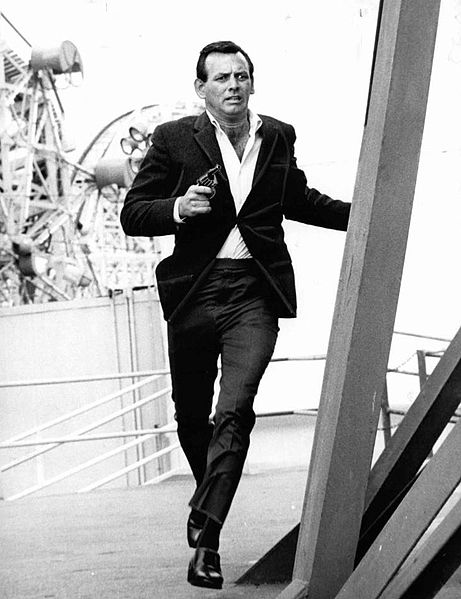Tags
1950s, book review, Cleveland, Dr. Sam Sheppard, Eliot Ness, Erle Stanley Gardner, hard-boiled detective, historical fiction, Marilyn Sheppard, Max Allan Collins, murder, mystery, sexism, superb plotting, The Fugitive, true crime fictionalized
Review: Do No Harm, by Max Allan Collins
Forge, 2020. 297 pp. $28
This much is history: During the early morning hours of July 4, 1957, someone bludgeons Marilyn Sheppard to death in her suburban Cleveland bedroom after a possible attempted rape, which she seems to have violently resisted. Suspicion immediately falls on her doctor husband, who nevertheless claims he was asleep on a daybed one floor below. He insists he rushed to her aid when he heard her screams and suffered a physical assault from the killer that damaged a vertebra in his neck.

Actor David Janssen playing Dr. Richard Kimble in the final episode of The Fugitive, 1967, a much-acclaimed ABC television series loosely based on the Marilyn Sheppard murder case. My high school classmates often talked about the show (courtesy Wikimedia Commons; public domain in the United States, as the image first appeared without a copyright tag)
The crime becomes notorious, largely because a Cleveland newspaper beats the drum for Dr. Sam Sheppard’s conviction even before his trial begins. Other irregularities mark the prosecution, not least the judge’s refusal to grant a change of venue; a lackadaisical approach to forensic evidence that suggests prejudice against the defendant; and testimony that borders on hearsay. Even so, Dr. Sam, as he’s known, behaved strangely right after the murder, and his two brothers, also physicians, tried to shield him in ways that arouse suspicion. Just before Christmas, a court convicts Dr. Sam and sentences him to prison.
Enter Nathan Heller, Chicago private investigator (and Collins’s creation, unlike many characters in this true-crime novel). Having visited the crime scene hours after the killing in the company of his friend Eliot Ness, Nate has glimpsed physical evidence as well as what the police and coroner do or fail to do. Not only that, he’s a hotshot with a national reputation. Consequently, in subsequent years, when the mystery writer Erle Stanley Gardner (creator of Perry Mason) takes an interest in the case and hopes to discover whether a retrial is warranted, he calls on his friend Nate.
Naturally, the Ohio authorities take a dim view, so Nate must be slicker than Brylcreem if he’s to interview the key players. All fear exposure, in one way or another. But as our hero sifts through the conflicting stories, he faces setbacks, and the trail goes cold over the years. Even so, the narrative that results, the search for new evidence and the real killer—if it’s not Dr. Sam—won’t let you go.
This is where Collins excels. He knows everything there is to know about the case but uses only the most relevant details. The reader follows Nate as he probes one possible suspect, then another, yet the more he learns, the murkier things get. Just when you think he’s nailed down the truth, you find he hasn’t, and not until the very end do you discover the most likely solution.
Collins’s style has been compared to Raymond Chandler’s, and though I won’t go that far, Do No Harm offers its verbal pleasures. A Dictaphone machine “hugged the desk like a frightened time traveler”; “You could have sliced the smoke in here and sold it for bacon”; and “peeling brown paint, like the ugliest suntan in history” decorates one scene of operations. Consider the previous paragraph describing that locale:
To some, the Cleveland Flats, situated on the bottomland of the river’s floodplain, was an industrial wonder — shipyards, foundries, oil refineries, chemical plants, lumber yards, flour mills. To me, the Flats would always be a hellish collection of gin joints and warehouses, where sailors and workingmen wandered in a dank, dark world lit by flickering neon and open flames from gas runoff, the silence broken by honky-tonk music and the fingernails-on-blackboard screeches of factories across the river. Some of these dives dated back to the turn of the century, piles of brick held together by sweat, sawdust and swill.
I recommend reading Do No Harm, but I’m unlikely to try another Nathan Heller novel. When I said the PI had to be slick, that he is. He never makes a mistake, and setbacks don’t throw him. Powerbrokers tell him no or move to block him, but he doesn’t care. You know he’ll work around them if he can’t go through them. Cornered by three punks who’ve gotten the drop on him? Pity them. Attractive women, and there are many, all flirt with him, and he has a way of viewing women as sex objects first and anything else second. Maybe that’s the hard-boiled genre, and it was probably unremarkable in the 1950s, if not the later decade, as the story progresses. But it’s nevertheless distasteful, especially since Nate never has an inconvenient feeling, if any at all, so he seems like a robot wired for high-voltage sex drive.
Given all that, if you read Do No Harm, you know what you’re getting: a throwback, for better and worse, and a ripping good story.
Disclaimer: I obtained my reading copy of this book from the public library.
